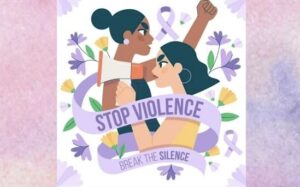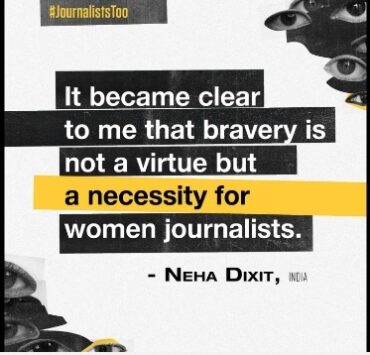
By Editors

This guide covers the basics of how to report gender based violence sensitively. The information in this guide has been put together by NWMI members Ranjitha Gunasekaran, Assistant Resident Editor for Tamil Nadu, The New Indian Express, and Ragamalika Karthikeyan, Editor-Special Projects and Experiments, The News Minute, based on a workshop held in May 2021 by the Network of Women in Media, India and The Prajnya Trust.
The UNHCR defines Gender Based Violence as “harmful acts directed at an individual based on their gender. It is rooted in gender inequality, the abuse of power and harmful norms. Gender based violence (GBV) is a serious violation of human rights and a life-threatening health and protection issue.”
GBV includes violence against cisgender women, against children, against LGBTQI+ people, and against anyone who doesn’t follow socially prescribed, stereotypical gender norms. It can manifest in different forms, including street sexual harassment, workplace sexual harassment, rape/attempted rape, domestic violence, and verbal, financial, or emotional abuse.
Covering GBV
For the media, covering GBV includes reporting individual instances of violence, reporting or writing about specific issues (eg, forced marriages in a state), reporting about interventions to address GBV. It may take the form of data journalism or reporting patterns in GBV.
Before We Start
A crime report is often the end result of an existing problem. Find ways to flag the existence of GBV in society: domestic violence, sex selection through abortion or infanticide, violence against women of particular castes and communities, etc, without waiting for particularly horrible crimes to peg such stories on.
GBV is often seen only through lenses of crime and sexual violence, but it includes domestic violence, workplace harassment, sex selective abortion, female infanticide, and child marriage.
GBV is not just sexual violence. It is violence when someone is forcibly thrown out of their homes – whether by the family, or landlords. It is violence when queer persons are denied jobs. It is violence when a person is humiliated for their gender expression/sexuality at the workplace or anywhere.
Importantly, GBV also includes differential access to resources and opportunities; and inequitable access is often compounded by factors of caste, class, creed, etc.
Check if all facts of the case are represented correctly, and if the facts add up. Ensure that the identities of the people involved, especially victims/survivors, are protected. Do not sensationalise but do not resort to euphemisms either.
The Source
Whenever possible, speak to multiple sources, with different perspectives. Approach every story with a view to finding out what diverse people may have at stake. Studies like the Global Media Monitoring Project have shown there are more male than female voices even in stories about violence against women. Track the process and progress of the case.
The police force is made up of human beings and is a social institution. Neither individuals nor the institution as a whole should be viewed as neutral figures. Just getting the police version of any incident is not enough for a story. Always report critically. This does not mean criticising but questioning. It means not accepting assertions at face value without further probing.
Is Gender the Only Identity At Play in GBV?
No. It is important to place crimes in context and to recognise and sensitively highlight intersecting identities and/or systemic issues that may have contributed to the violence. Follow up on stories, and be intersectional in your approach (an intersectional approach acknowledges systemic discrimination due to different aspects of one’s identity like gender, sexual orientation, caste, class, race etc).
There is no doubt that laws in India need to evolve. They are not just lacking, they are actively harmful in many cases. This, too, needs to be highlighted.
What to avoid
1. Avoid description of graphic violence. In cases involving marginalised people, description of graphic violence can lead to further dehumanisation. It can also be triggering for many readers/viewers and is unnecessary to highlight the unacceptability of violence.
2. Avoid contributing to stereotypical ideas about the “good victim” and what constitutes “correct behaviour” on the part of victims of crimes.
3. Avoid describing women above 18 as ‘girls’ or using the term ‘a female’. Use the word ‘woman’.
4. Avoid using archaic and inaccurate terms like ‘eve teasing’ or ‘catcalling’. The correct term for such violence is street sexual harassment/sexual harassment. The perpetrators are not ‘eve-teasers’ but ‘sexual harassers’.
5. Avoid using terms like ‘jilted lover’ to describe those who harass individuals who they were once in a relationship with or wish they were. Such perpetrators are ‘stalkers’.
Reporting on violence against LGBTQI+ people
LGBTQIA+ stands for Lesbian, Gay, Bisexual, Transgender, Queer, Questioning, Intersex, Asexual. It can include lots of other identities, including but not limited to Demisexual, Aromantic, Pansexual, Agender, Bigender, and Pangender.
Queer is an umbrella term that can be used in many contexts – but not all.
Try to place the story within the larger context of violence against LGBTQI+ people. While covering suicide brought on by discrimination/harassment, are you looking at different aspects of the tragedy so that the real, whole story emerges or relying only on the police version?
When speaking to people
1. Ask people what their pronouns are, not ‘preferred’ pronouns – just pronouns. And respect their pronouns. You can read up on the usage of pronouns here.
2. Think about whose voices are being amplified in the story. Use more voices that are representative in the context of the story. For example, should you be quoting a cis gay man for a story about a lesbian couple?
3. Try to diversify your sources. Ensure that the voices of queer persons are heard. And while we are at it, we could work to ensure the voices of queer persons in stories NOT about violence against them are heard too.
4. While reporting on violence against LGBTQI+ people, avoid using outdated and/or pejorative terms like ‘third gender’, ‘MSM’, eunuch etc., unless a person specifically uses that term to describe their identity. Look up the correct usage of terms. For instance, ‘a transgender’ or ‘transgenders’ is wrong. The correct terms are transgender person/s, trans person, trans woman, trans man and so on.
5. Avoid deadnaming anyone (the name that a transgender person was given at birth and no longer uses upon transitioning).
6. Add useful information like suicide helplines, helplines for queer people, links to resources like free or affordable healthcare, and links to stories that explain legal/policy provisions available for LGBTQI+ people.
Keep in mind two questions: Will your reporting further harm the people involved? Are the words and images you use respectful or derogatory?
Reporting on Child Sexual Abuse
Child sexual abuse (CSA) involves engaging a child in sexual activity in pursuit of the abuser’s sexual gratification. Under the Protection of Children from Sexual Offences Act (POCSO), children cannot consent to sexual activity.
1. While reporting on CSA, protect the identity of the child.
2. Do not conflate homosexuality with paedophilia.
3. Again, do not sensationalise but do not resort to euphemisms either.
4. Remember to use legal or medical terminology.
5. Provide adequate context in the story. Consider where identities (gender, caste, class etc) of the survivor vs the accused intersect, and look at factors that made the child involved extra vulnerable.
6. Provide resources to access child welfare support whenever possible.
Keep in mind the following questions : Were there barriers to filing a complaint? Did the child receive, or was the child refused, medical attention? Has the child accessed compensation or received psycho-social support? Has a chargesheet been filed? How is the child being treated in court? What is the pursuit of justice costing the family – socially, economically, mentally, etc.? What is the role of Child Welfare Committees/District Child Protection Unit Officers?
Apart from reporting on the crime story, journalists can examine judgments/court orders to find other, in-depth stories which look at related issues surrounding CSA.
For more resources, click here.




